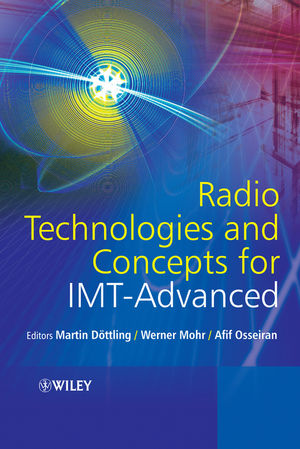Radio Technologies and Concepts for IMT-AdvancedISBN: 978-0-470-74763-6
Hardcover
624 pages
October 2009
 Other Available Formats: E-book
|
||||||
Preface.
Acknowledgements.
Abbreviations.
List of Contributors.
1 Introduction.
1.1 Development and Status of Mobile and Wireless Communications.
1.2 Expectations of Data Traffic Growth.
1.3 Development Towards IMT-Advanced.
1.4 Global Research Activities.
1.5 WINNER Project.
1.6 Future Work.
References.
2 Usage Scenarios and Technical Requirements.
2.1 Introduction.
2.2 Key Scenario Elements.
2.3 Service Classes and Service Requirements.
2.4 Requirements for System Capabilities.
2.5 Terminal Requirements.
2.6 Performance Requirements.
2.7 Spectrum Requirements.
2.8 Dependency of Requirements.
2.9 Conclusion.
Acknowledgements.
References.
3 WINNER II Channel Models.
3.1 Introduction.
3.2 Modelling Considerations.
3.3 Channel-Modelling Approach.
3.4 Channel Models and Parameters.
3.5 Channel Model Usage.
3.6 Conclusion.
Acknowledgements.
References.
4 System Concept and Architecture.
4.1 Introduction.
4.2 Design Principles and Main Characteristics.
4.3 Logical Node Architecture.
4.4 Protocol and Service Architecture.
4.5 Conclusion.
Acknowledgements.
References.
5 Modulation and Coding Techniques.
5.1 Introduction.
5.2 Basic Modulation and Coding Scheme.
5.3 Coding Schemes.
5.4 Link Adaptation.
5.5 Link Level Aspects of H-ARQ.
5.6 Conclusions.
References.
6 Link Level Procedures.
6.1 Introduction.
6.2 Pilot Design.
6.3 Channel Estimation.
6.4 Radio Frequency Impairments.
6.5 Measurements and Signalling.
6.6 Link Level Synchronisation.
6.7 Network Synchronisation.
6.8 Conclusion.
Acknowledgements.
References.
7 Advanced Antennas Concept for 4G.
7.1 Introduction.
7.2 Multiple Antennas Concept.
7.3 Spatial Adaptation.
7.4 Spatial Schemes.
7.5 Interference Mitigation.
7.6 Pilots, Feedback and Measurements.
7.7 MIMO Aspects in Relaying.
7.8 Conclusion.
Acknowledgements.
References.
8 Layer-2 Relays for IMT-Advanced Cellular Networks.
8.1 Introduction.
8.2 Motivation for Layer-2 Relays and Prior Work.
8.3 Relay-based Deployments.
8.4 Design Choices for Relay-based Cellular Networks.
8.5 System and Network Aspects.
8.6 System-level Performance Evaluation.
8.7 Conclusion.
Acknowledgements.
References.
9 Multiple Access Schemes and Inter-cell Interference Mitigation Techniques.
9.1 Introduction.
9.2 Multiple Access Schemes.
9.3 Inter-cell Interference Mitigation Schemes.
9.4 Conclusion.
Acknowledgements.
References.
10 Radio Resource Control and System Level Functions.
10.1 Introduction.
10.2 IPCL Layer.
10.3 Radio Resource Control.
10.4 Centralised, Distributed and Hybrid RRM Architecture.
10.5 System-Level Performance Results.
10.6 Conclusion.
Acknowledgements.
References.
11 Sharing and Flexible Spectrum Use Capabilities.
11.1 Introduction.
11.2 Spectrum Technologies Framework.
11.3 Detailed Design of a Spectrum Assignment Negotiation Mechanism.
11.4 Spectrum Assignment Enabling Mechanisms.
11.5 WINNER Sharing with FSS.
11.6 Performance Evaluation of Spectrum Assignment Mechanisms.
11.7 Conclusion.
Acknowledgements.
References.
12 ITU-R Spectrum Demand Calculation for IMT-Advanced.
12.1 Introduction.
12.2 ITU-R Work on Spectrum Requirements of IMT-Advanced.
12.3 ITU-R Spectrum Calculation Methodology.
12.4 Software Implementation of Methodology.
12.5 Estimated Spectrum Requirements of IMT-Advanced.
12.6 Conclusion.
Acknowledgements.
References.
13 System Model, Test Scenarios, and Performance Evaluation.
13.1 Introduction.
13.2 Performance Assessment of Wireless Networks.
13.3 Interface between Link and System Simulations.
13.4 Test Scenarios.
13.5 Spectral Efficiency and Number of Satisfied Users under QoS Constraints.
13.6 End-to-End Performance Evaluation.
13.7 Conclusion.
Acknowledgements.
References.
14 Cost Assessment and Optimisation for WINNER Deployments.
14.1 Introduction.
14.2 Cost Assessment Framework and Assumptions.
14.3 Cost Components.
14.4 Cost Assessment Models.
14.5 Reference Deployment Scenarios and Cost Assessments.
14.6 Conclusion.
Acknowledgements.
References.
Index.



